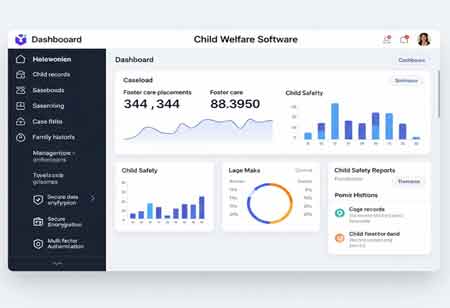THANK YOU FOR SUBSCRIBING
Be first to read the latest tech news, Industry Leader's Insights, and CIO interviews of medium and large enterprises exclusively from Gov CIO Outlook
THANK YOU FOR SUBSCRIBING

By
Government CIO Outlook | Friday, September 05, 2025
Stay ahead of the industry with exclusive feature stories on the top companies, expert insights and the latest news delivered straight to your inbox. Subscribe today.
The adoption of specialized software solutions primarily drives the delivery of child welfare services. These digital platforms are fundamentally reshaping how agencies manage cases, support families, and ensure the well-being of children. Far from being mere record-keeping tools, modern child welfare software is emerging as a comprehensive ecosystem designed to enhance efficiency, facilitate collaboration, and ultimately improve outcomes for vulnerable populations.
Core Functionalities and Operational Efficiency
At its core, child welfare software provides a centralized system for managing the vast array of data associated with child protection and family support. This includes intricate details on individual children and families, historical case information, assessment results, and service plans. The objective is to transition from disparate, often paper-based systems to a cohesive digital environment where information is readily accessible and consistently updated. This consolidation of data enables a holistic view of each case, allowing professionals to make more informed decisions and track progress effectively.
The functionalities embedded within these software systems are extensive and continually expanding. Key features typically include robust intake and referral management, allowing agencies to efficiently process initial reports of concern and route them to the appropriate channels. Case management modules form the backbone of these systems, providing tools for detailed record-keeping of interactions, observations, and interventions. This encompasses everything from documenting home visits and counseling sessions to tracking legal proceedings and court orders.
Beyond individual case tracking, child welfare software is designed to streamline administrative processes and procedures. This often involves automated workflows for tasks such as scheduling appointments, managing foster home placements, and tracking financial assistance provided to families. The ability to generate comprehensive reports is another critical functionality, enabling agencies to analyze trends, measure program effectiveness, and meet various compliance and reporting requirements. This data-driven approach is becoming increasingly vital for accountability and continuous improvement within the sector.
Fostering Collaboration and Communication
Modern child welfare software emphasizes features that promote collaboration and communication among diverse stakeholders. This includes tools that facilitate secure information sharing between social workers, legal professionals, healthcare providers, educators, and other support services involved in a child's life. Such interconnectedness helps break down traditional silos, ensuring that all parties are working with the most up-to-date information and towards common goals. Secure portals for families and caregivers are also becoming more prevalent, fostering greater engagement and transparency by providing them with access to relevant information about their case and available resources.
The benefits derived from implementing these sophisticated systems are multi-faceted. One of the most significant advantages is the considerable enhancement in operational efficiency. By automating routine tasks and centralizing data, social workers and administrators can dedicate more time and resources to direct client interaction and critical decision-making, rather than being bogged down by administrative overhead. This shift in focus directly contributes to improved service delivery and increased capacity within agencies.
These systems contribute to greater consistency and standardization in practice. With structured data entry and standardized workflows, agencies can ensure that best practices are followed and that all relevant information is captured consistently across cases. This not only improves the quality of service but also supports evidence-based interventions by providing a richer dataset for analysis. The ability to quickly retrieve and analyze historical data also facilitates the identification of patterns and informs future strategies.
Future Trajectories and Holistic Approaches
Advancements heavily influence the evolution of child welfare software in technology. The shift towards cloud-based platforms has made these systems more accessible, scalable, and secure, allowing agencies to access critical information from various locations, including in the field through mobile applications. This mobility empowers social workers to be more responsive and efficient, capturing data and updating cases in real-time, even when away from the office.
The trajectory of child welfare software points towards even greater sophistication and integration. The increasing adoption of data analytics and artificial intelligence (AI) is set to revolutionize decision-making processes. Predictive analytics can help identify children at higher risk of maltreatment, enabling proactive interventions. AI-powered tools also help streamline resource allocation and personalize support services based on individual family needs. The emphasis will continue to be on systems that are highly configurable, adaptable to evolving policy landscapes, and seamlessly integrated with broader human services ecosystems.
The overarching aim remains to create a comprehensive, child-centric approach to welfare. Software solutions are evolving beyond simply managing cases to actively support prevention efforts, foster family preservation, and promote long-term well-being. This involves a greater focus on integrating services across various domains, including mental health, education, housing, and employment, all underpinned by a robust technological framework that facilitates information flow and coordinated care. The future of child welfare is undeniably digital, with technology serving as a powerful enabler for positive change and improved outcomes for children and families.
I agree We use cookies on this website to enhance your user experience. By clicking any link on this page you are giving your consent for us to set cookies. More info

However, if you would like to share the information in this article, you may use the link below:
www.govciooutlookapac.com/news/the-digital-evolution-of-child-welfare-systems-nid-2493.html



